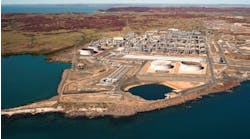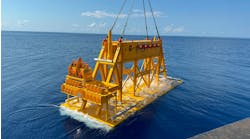Australia’s offshore energy regulator NOPSEMA issued an environmental alert Oct. 3 after a shark was found caught in a pre-existing rope loop attached to an underwater electrical flying lead.
During a subsea survey, an ROV operator noticed a live shark caught in the rope loop, and the rope was cut using an ROV knife, allowing the shark to swim away. NOPSEMA said no additional harm was caused while releasing the shark.
The regulator explained that it is common industry practice during installation of some subsea equipment to affix rope loops or other installation aids to equipment to enable ROVs to maneuver the equipment into position, minimize the risk of damage to the equipment and/or assist with later removal.
NOPSEMA said it is also aware that other adverse fauna-equipment interactions have occurred in the industry, including interactions directly with ROVs, and that these have been inconsistently reported or not reported to the regulator.
If installation aids are not removed, cut or otherwise made safe (e.g., by design), they can present a risk of entanglement to marine fauna.
In addition to installation aids, other subsea equipment that uses lights, cables or thrusters has
potential to attract attention from marine animals, which may result in entanglement or other adverse interactions, NOPSEMA cautioned.
While in this incident the shark was released safely, NOPSEMA said it is likely a similar incident could result in serious injury or death to an animal.
Suggested control measures to be considered include:
- Implementation and verification of requirements for the removal/recovery of installation aids or other subsea debris during installation, construction, and ongoing inspection, maintenance and repair activities;
- Alternative design of installation aids, such as monkey fist knots, clamps or lifting pads,
including those that can be made safe when not in use; and - Design of equipment or installation of protective guards that prevent interaction with
thrusters and other mechanisms of potential injury.



